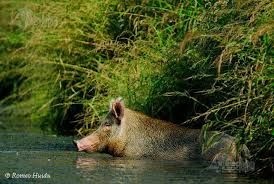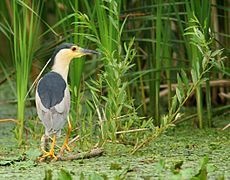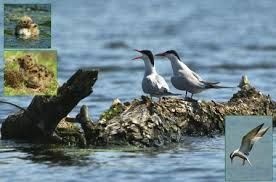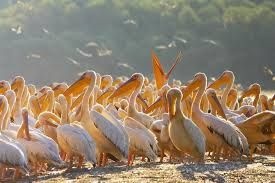The Danube Delta falls within Pannonian steppe ecosystem of eastern Europe, with Mediterranean influences. As a young region in full process of consolidation, the Danube Delta represents a very favourable place for the development of highly diverse flora and fauna, unique in Europe, with numerous rare species. It hosts 23 natural ecosystems, but due to the extent of wetlands the aquatic environment is prevalent; the terrestrial environment is also present on the higher grounds of the continental levees, where xerophile ecosystems have developed. Between the aquatic and terrestrial environments, is interposed a swampy, easily flooded strip of original flora and fauna, with means of adaptation for water or land, depending on the season or the hydrological regime. At the contact between freshwater and sea water, some special physical, chemical and biological processes take place, which have led biologists to consider this area as a very different ecosystem called beforedelta. Musura Gulf, north of Sulina, and Saint George Gulf are considered the most representative for this type of ecosystem.
Situated on major migratory routes, and providing adequate conditions for nesting and hatching, the Danube Delta is a magnet for birds from six major eco-regions of the world, including the Mongolian, Arctic and Siberian. There are over 320 species of birds found in the delta during summer,[8] of which 166 are hatching species and 159 are migratory. Over one million individuals (swans, wild ducks, bald coots, etc.) winter here.
Ecosystems of running water[edit]
It comprises the Danube arms, as well as a series of more important streamlets and channels. It is an environment rich in plankton, worms, mollusca, grubs, spongiae, with numerous species of fish, such as the carp, pike perch, sheat fish, and freshwater sturgeons (sterlet, Vyza and Danube mackerel).
Ecosystem of stagnant water[edit]
Includes the lakes, to which various ponds, streamlets and channels are added. They are characterized by a rich floating and submerse flora (Myriophyllum, Ceratophyllum, Vallisneria etc. under the water;Nymphaea alba, Nuphar lutea, Trapa natans, Alisma plantago etc., floating plants with roots near the lakes borders; Salvinia natans, Stratiotes aloides, Spirogyra etc., floating plants without roots, having negative effects for the aquatic bioproductivity). Of the fish, the most important are Tinca tinca, Abramis brama, Scardinius erytrophalmus, Carassius auratus gibelio, Silurus glanis, Perca fluviatilis, Esox luciusetc.
Ecosystems of marshy and flooding areas[edit]




The reed plats and floating reed islands (called plaur inRomania) are the most common and well known components of the Danube Delta. Vegetation of this ecosystem consists of common reed (Phragmites communis), and near river banks mace reed/cattail (Typha latifolia, Typha angustifolia), sedge (Carex dioica, Carex stricta), Dutch rush (Scirpus radicans,Scirpus lacustris), brook mint (Mentha aquatica) etc. They constitute ideal spawning and nesting grounds. The plaur is a mixture of reed roots, grass and soil, usually floating or anchored on the bottom. As a rule, the reed surrounds the lakes and ponds, slowly invading the water surface.
This type of ecosystem is noted for the variety and large populations of birds, some of them very rare. The most important are the tufted duck (Aythya fuligula, red crested pochard (Netta rufina), mallard (Anas platyrhynchos), greylag goose (Anser anser), pygmy cormorant (Phalacrocorax pygmaeus), purple heron (Ardea purpurea), great white egret (Egretta alba), little egret (Egretta garzetta), Spoon bill (Platalea leucorodia), white pelican (Pelecanus onocrotalus), Dalmatian pelican (Pelecanus crispus), mute swan (Cygnus olor), glossy ibis (Plegadis falcinellus). A recent and welcomed spreading has the pheasant (Phasianus colchicus).
Among the mammals, there is the otter (Lutra lutra), mink (Mustela lutreola), little ermine (Mustela erminea aestiva), wild boar (Sus scrofa), wild cat (Felis silvestris), and in the winter, the hare (Lepus europaeus), and on the brink of disappearing from the delta, the wolf and the fox. The East Asian raccoon dog (Nyctereutes procyonoides), bizam/introduced muskrat (Ondatra zibethica), and to some extent South American nutria (Myocastor coypus) are recent species successfully adapted.



